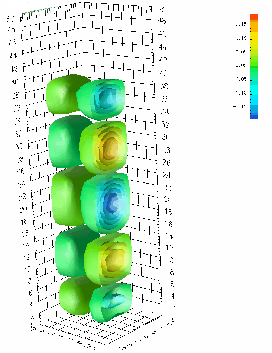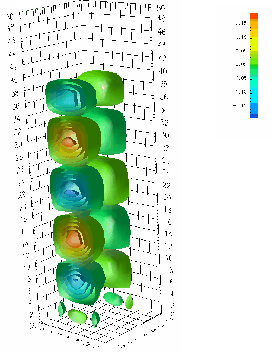



Next: 8.3 Diffusion Simulation
Up: 8. Generic Application Design
Previous: 8.1 Visual Programming
8.2 Wave Equation
An example using the discrete concepts of electromagnetics in
conjunction with the comprehensive operations of the GSSEis
provided. It translates the continuous formulation of Maxwell's
equations given in Section 1.2 with
internally oriented
 and externally oriented
and externally oriented
 fields, including their linking relations
fields, including their linking relations
into a discrete setting, by applying the discrete concepts of chains
and cochains (Section 1.4 and
Section 1.7). Figure
8.4 presents the discrete form of
Faraday's and Amperé's law.
Figure 8.4:
The left figure depicts Faraday's law by the corresponding projection onto a finite cell, whereas the right figure illustrates Amperé's law.
![\begin{figure}\begin{center}
\small\psfrag{H12} [c]{\textcolor{blue}{$\ensurem...
...figures/application/wave_01.eps, width=0.85\textwidth}\end{center}\end{figure}](img772.png) |
Using a projection of the averaged field components onto 2-cells,
local representatives of the global quantities are obtained. See Section
2.4.3 for more details. The following
equation expresses this fact:
By utilizing the quantity accessor mechanisms and the traversal
operations of the GSSE, the equation can be rewritten as a discrete
formulation, where the the electric field quantity is located on edges
 and the magnetic field quantity is located on facets
and the magnetic field quantity is located on facets
 . The permittivity, permeability, and spatial
resolution are omitted to emphasize the topological traversal capabilities:
. The permittivity, permeability, and spatial
resolution are omitted to emphasize the topological traversal capabilities:
![$\displaystyle \mathcal{L}_\mathrm{B\_fdm} (B)\equiv \frac{ B_{\mathrm{f}}- B^{\...
...t} = \; \Delta_{\mathrm{f}\rightarrow \mathrm{e}} \bigl [ E_\mathrm{e} \bigr ],$](img777.png) |
(8.4) |
where
 denotes the traversal of
all edges incident to a face.
The topological traversal mechanism is presented in the following code
snippet, where the constitutive laws are used to interpolate the
corresponding quantities.
denotes the traversal of
all edges incident to a face.
The topological traversal mechanism is presented in the following code
snippet, where the constitutive laws are used to interpolate the
corresponding quantities.
![\begin{lstlisting}[frame=lines,label=beispielcode_wave,caption=]{}
// ..
H += d...
...m<facet,-1>() [ E ]
E += delta_t * sum<edge ,+1>() [ H ]
// ..
\end{lstlisting}](img779.png)
The  -component and
-component and  -component of the final vector field
-component of the final vector field
 is depicted in Figures
8.5-8.6
for a three-dimensional calculation. The x-y plane with a spatial
dimension of
is depicted in Figures
8.5-8.6
for a three-dimensional calculation. The x-y plane with a spatial
dimension of
 units at the bottom uses a simple
harmonically oscillating quantity and is also used as a Dirichlet
contact. Neumann boundary conditions are applied to the remaining
boundary planes.
units at the bottom uses a simple
harmonically oscillating quantity and is also used as a Dirichlet
contact. Neumann boundary conditions are applied to the remaining
boundary planes.
|
|
|
Figure 8.5:
Illustration of the  -component of
-component of
 with a harmonic oscillating source in the x-y plane at two different time steps.
with a harmonic oscillating source in the x-y plane at two different time steps. |
 |
 |
Figure 8.6:
Wave equation with a harmonic oscillating source in the x-y
plane where the source is switched off. The  -component of
-component of
 is depicted on the right side.
is depicted on the right side.
|




Next: 8.3 Diffusion Simulation
Up: 8. Generic Application Design
Previous: 8.1 Visual Programming
R. Heinzl: Concepts for Scientific Computing
![]() and externally oriented
and externally oriented
![]() fields, including their linking relations
fields, including their linking relations
![\begin{figure}\begin{center}
\small\psfrag{H12} [c]{\textcolor{blue}{$\ensurem...
...figures/application/wave_01.eps, width=0.85\textwidth}\end{center}\end{figure}](img772.png)
![$\displaystyle \mathcal{L}_\mathrm{B\_fdm} (B)\equiv \frac{ B_{\mathrm{f}}- B^{\...
...t} = \; \Delta_{\mathrm{f}\rightarrow \mathrm{e}} \bigl [ E_\mathrm{e} \bigr ],$](img777.png)
![\begin{lstlisting}[frame=lines,label=beispielcode_wave,caption=]{}
// ..
H += d...
...m<facet,-1>() [ E ]
E += delta_t * sum<edge ,+1>() [ H ]
// ..
\end{lstlisting}](img779.png)
![]() -component and
-component and ![]() -component of the final vector field
-component of the final vector field
![]() is depicted in Figures
8.5-8.6
for a three-dimensional calculation. The x-y plane with a spatial
dimension of
is depicted in Figures
8.5-8.6
for a three-dimensional calculation. The x-y plane with a spatial
dimension of
![]() units at the bottom uses a simple
harmonically oscillating quantity and is also used as a Dirichlet
contact. Neumann boundary conditions are applied to the remaining
boundary planes.
units at the bottom uses a simple
harmonically oscillating quantity and is also used as a Dirichlet
contact. Neumann boundary conditions are applied to the remaining
boundary planes.

